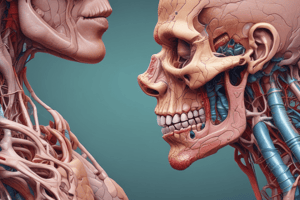Podcast
Questions and Answers
Which salivary gland is exclusively responsible for producing serous saliva?
Which salivary gland is exclusively responsible for producing serous saliva?
- Submandibular gland
- Mandibular gland
- Sublingual gland
- Parotid gland (correct)
What is the main duct associated with the submandibular gland?
What is the main duct associated with the submandibular gland?
- Bartholin’s duct
- Stensen’s duct
- Wharton’s duct (correct)
- Rivinus duct
Which of the following statements correctly describes the innervation of the submandibular gland?
Which of the following statements correctly describes the innervation of the submandibular gland?
- Innervated by the glossopharyngeal nerve
- Innervated by the facial nerve only
- Innervated by chorda tympani and the lingual branch of the inferior dental nerve (correct)
- Innervated by the auriculotemporal nerve
How much of the total saliva volume is produced by the submandibular gland?
How much of the total saliva volume is produced by the submandibular gland?
Which type of saliva does the sublingual gland predominantly secrete?
Which type of saliva does the sublingual gland predominantly secrete?
What anatomical location is the parotid gland found in relation to the ear?
What anatomical location is the parotid gland found in relation to the ear?
Which structure is NOT a part of the duct system in salivary glands?
Which structure is NOT a part of the duct system in salivary glands?
What role do myoepithelial cells play in salivary glands?
What role do myoepithelial cells play in salivary glands?
What is the composition of salivary glands on a histological level?
What is the composition of salivary glands on a histological level?
How much saliva volume does the sublingual gland contribute?
How much saliva volume does the sublingual gland contribute?
Flashcards
What type of saliva does the parotid gland produce?
What type of saliva does the parotid gland produce?
The parotid gland is the largest salivary gland and produces a serous saliva type.
Where is the parotid gland located?
Where is the parotid gland located?
The parotid gland is located below the external auditory meatus, between the mastoid process and the posterior border of the ramus.
Describe the path of the parotid duct.
Describe the path of the parotid duct.
The parotid duct, also known as Stensen's duct, runs from the gland outside the masseter muscle, parallel to and 1cm below the zygomatic arch. It pierces the buccinator muscle and opens into the oral cavity via the stensen's papillae.
What type of saliva does the submandibular gland produce?
What type of saliva does the submandibular gland produce?
Signup and view all the flashcards
Where is the submandibular gland located?
Where is the submandibular gland located?
Signup and view all the flashcards
What is the name of the duct associated with the submandibular gland?
What is the name of the duct associated with the submandibular gland?
Signup and view all the flashcards
What type of saliva does the sublingual gland produce?
What type of saliva does the sublingual gland produce?
Signup and view all the flashcards
Where is the sublingual gland located?
Where is the sublingual gland located?
Signup and view all the flashcards
What are the ducts associated with the sublingual gland?
What are the ducts associated with the sublingual gland?
Signup and view all the flashcards
What are acini in salivary glands?
What are acini in salivary glands?
Signup and view all the flashcards
Study Notes
Major Salivary Glands
-
Parotid:
- Primarily serous saliva (100%)
- Accounts for 25% of total saliva volume.
- Located beneath the external auditory meatus, between the mastoid process and the posterior border of the ramus.
- Duct: Stensen's (Parotid) duct.
- Duct runs from the gland, outside the masseter muscle, parallel to and 1cm below the zygomatic arch.
- Duct penetrates the buccinator muscle, opening into the oral cavity at Stensen's papillae.
- Innervation: Glossopharyngeal (autonomic), Auriculotemporal (sensory). Closely associated with the facial nerve.
-
Submandibular:
- Mixed saliva secretions (serous and mucous)
- Accounts for 60-65% of total saliva volume.
- Positioned between the body of the mandible and the mylohyoid muscle, in the submandibular fossa.
- Duct: Wharton's duct.
- Duct opens under the anterior part of the tongue, lateral to the lingual frenum at the sublingual caruncle.
- Innervation: Chorda tympani, lingual branch of the inferior dental nerve.
-
Sublingual:
- Primarily mucous saliva (60%)
- Accounts for 5-10% of total saliva volume.
- Located on the floor of the mouth, in the sublingual fossa.
- Duct: Bartholin's duct, and 10-20 smaller ducts (Rivinus ducts) that open along the sublingual fold.
- Innervation: Chorda tympani, lingual branch of the inferior dental nerve.
Histological Structure of Salivary Glands
- Composed of epithelium and connective tissue.
- Key components:
- Acinar: Secretory units that produce saliva, arranged in small, pear-shaped groups, consisting of serous, mucous, or both cell types.
- Ducts: A system that modifies saliva, dividing into intercalated, striated, and excretory segments.
- Myoepithelial cells: Contractile cells associated with gland tissue, playing a crucial role in secretion.
Salivary Gland Disorders
- Hyposalivation: Reduced saliva production, caused by medications, radiation therapy, immune diseases, diabetes, salivary stones.
- Obstruction:
- Caniculi: Calcium deposits in ducts.
- Cysts: Formation caused by trauma to the gland or duct; saliva accumulates in surrounding tissue.
- Degenerative Disorders:
- Sjögren's syndrome: Autoimmune disorder, causing mild erythema and mucosa thinning, accompanied by mild erythema.
Studying That Suits You
Use AI to generate personalized quizzes and flashcards to suit your learning preferences.




